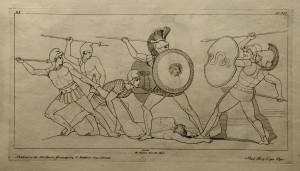The Iliad only covers the final several weeks of the Trojan War between the Greek armies of Agamemnon and the Trojan armies that lasted up to ten years. However, Homer’s tale written in a dactylic hexameter style of writing in ancient Greece has been greatly influential to many artists throughout history. In fact, the leading figure in European Neoclassic artwork, John Flaxman, had created many black and white draft pieces that would be later reproduced into sculptures.
John Flaxman was one of the most prolific sculptures of his time whose illustrations of the Iliad only increased the number of commissions he received. Like other artists that depicted a scene from the Iliad, his most popular draft work was that of Patroklos fighting over the body of Sarpedon by both the Greek and Trojan armies after he is killed by Patroklos.
In Book 15, the Trojans are driven back across the ditch to where their chariots are parked and the Gods immediately begin to rejuvenate the Trojans after a defeat. Zeus persuades Poseidon to leave the battlefield for conspiracy of helping the Greeks win the battle and he encourages Apollo to rejuvenate a wounded Hektor. With Hektor newly rejuvenated, the Trojans once again cross over the ditch towards the Greek Ships.
Upon seeing of this advancement, Patroklos weeps to Achilles of the Greek’s plight and begs Achilles for him to allow him to wear his armor and lead the Myrmidons into battle. Achilles agrees with a few exceptions that Patroklos is to follow. While Patroklos is adorning himself in Achilles armor, Achilles pours a libation to Zeus for his safe return. However, the libation is sadly wasted for Zeus knows the untimely fate of Patroklos.
During the battle, Patroklos kills many Trojan soliders including Sarpedon. Seeing the dead body of Sarpedon, Glaukos calls upon Apollo to protect his corpse, which Apollo does so by healing Glaukos’ wounds to allow him to collect a band of Trojans for the fight over Sarpedon’s body.
By understanding the context of Flaxman’s draft work, I can now go on to analyze the illustration. In comparison to Flaxman’s pieces of ceramic artwork, it is his illustrations that are considered far more complicated compositions. His Neoclassic illustrations of the retrieval of Sarpedon’s body consisted of clean lines and an uncomplicated design. The perspective of the draft adds shadows to the drawings making them two-dimensional. Also, the shadows depict a sense of movement and energy to the piece of art. The stance of the subjects, especially that of Patroklos, with their arrows pointing towards the enemy shows that the battle is continuing on. The sense of movement is even depicted as two of the Myrmidon soliders pulls at Sarpedon’s legs to drag him towards the Greek ships.
Flaxman’s use of black and white was purposely done so that his illustrations could be easily replicated when printed. But what they also invoke is one of the main themes of the tale, which is the impermanence of human life and its creations. Throughout the Iliad, Homer alludes to the notion that even the greatest of men cannot escape death; in fact, the greatest men may yield to death sooner than others. This is accurately depicted in Flaxman’s draft, as the reader is aware that Sarpedon was killed at a young age, yet the reader is also attentive that it is Patroklos who will soon be the next man who cannot escape death.
While gawking at John Flaxman’s depiction of the death of Sarpedon, I was easily conscious of why he chose this scene to create a draft out of the various other popular scenes he could have chosen. This scene marks a turning point in the epic poem itself, the point where Patroklos makes a grave mistake that ultimately ends in his death. With his death, Achilles is then provoked to join the battle on Agamemnon’s side to seek revenge against Hektor.
Furthermore, the visual delight of his illustration can also be received as a philosophical statement to what I have previously mentioned, the impermanence of human life. Throughout the tale, the presence of the Gods and Goddesses is constantly known and many soliders and humans’ alike call upon them for help. However, even with the presence of the Gods, not all humans can escape the untimely presence of death that haunts each and every one of them, including the children of Gods…


_Flaxman_Ilias_1795,_Zeichnung_1793,_188_x_344_mm.jpg)
http://www.artble.com/artists/john_flaxman